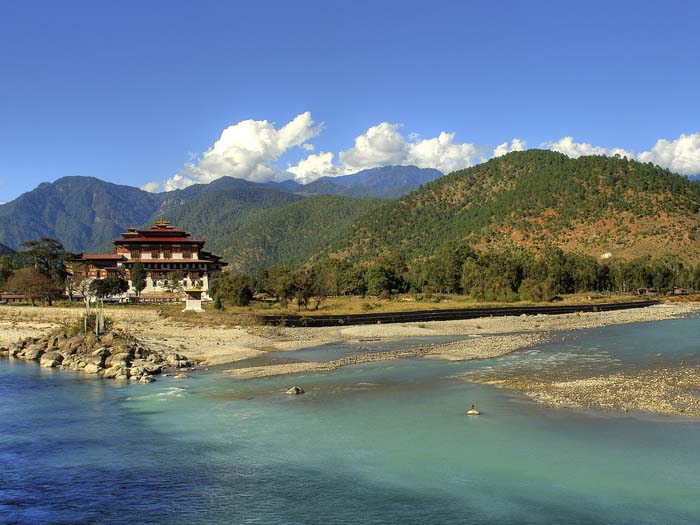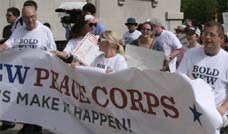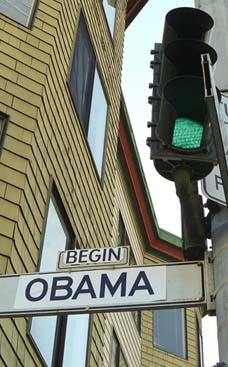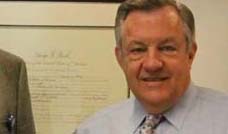
Besides the high foothills and snow-capped mountains, Bhutan’s temples (“dzongs”) were another attraction. Fortresses to begin with, the dzongs are perched high in the mountains, with sweeping views of the surrounding territory and often “decorated” with multi-colored “prayer flags” left by visitors. Nearly 3,000 feet high, the “Tiger’s Nest” is one picturesque example. Amid their walking and climbing exercise, while also adjusting to the altitude, the double-R sign, for restroom and restaurant, was always welcome. So was the collapsible cane Linda Mather had brought along, insuring her testy knee made it through the trip undamaged. (It did.) Buddhism involves looking out for others and the environment — a respect for life in general. And so, dogs might sit, or even nap, in the middle of a road, but vehicles stop for them. Similarly, in a village to which black- necked cranes return every year, the residents protect the birds by using solar panels instead of electric wires. “Plentiful, fresh and well-prepared” — so Linda Mather describes the food they enjoyed in Bhutan. After breakfasts of porridge, eggs, toast, the variety of “identifiable” elements typically featured unfussy steamed vegetables, with red rice and hot chilies, and meat or fish — all with tea. Dessert was often oranges. All told, the Mathers saw about 50 other foreigners during the entire three weeks. That, coupled with the surprising — and disappointing — reserve of the Bhutanese they met, even at the tsechus, pretty much threw them back on their own resources.
Don Mather had first heard of Bhutan decades ago while a Peace Corps volunteer in Pakistan
TRAVEL: Bhutan: Approaching the roof of the world
Tuesday, June 2, 2009 2:00 PM EDT
By Pat Summers Special Writer
Caption: Dzong of Punakha, located at the confluence of Mo Chhu and Pho Chhu (Mother River and Father River). Bhutan Photo: Marina & Enrique Flickr Creative Commons Attribution-Noncommercial-No Derivative Works 2.0 Generic
Editor’s note: Readers of The Princeton Packet are a well-traveled lot, but few can match Don and Linda Mather’s claim to have visited one of the world’s most remote nations — Bhutan.
Not for Don and Linda Mather alluring beaches or infinity pools, great shopping or extreme sports — and definitely not celebrity watching, renowned chefs or overcrowded popular sites. The Princeton couple toured Bhutan, the remote Buddhist country in the Himalayas, late last year.
It was neither a casual decision nor an easy trip to pull off, even for this widely traveled pair, whose last jaunts took them to Malaysia and South Africa. The Mathers, who had cultivated separate travel lusts till they met in 1969 and made it a team endeavor, returned home from Asia in late December.
Before their three-week tour, they spent an unexpected week in Bangkok when the protest that closed the airport locked them in place. So they shopped for swimsuits and tees while turtlenecks and long underwear, ready for climbing the foothills in winter-bound Bhutan, languished in their luggage.
With China to the north and India to the south, Bhutan has been described the least accessible and least known Himalayan country. The number of foreign visitors is restricted and the government licenses tours.
The Bhutanese population is estimated at 700,000 and the capital is Thimphu, in the western part of the country, near its only airport, at Paro. A monarchy for the last century, Bhutan crowned its fifth king of the Land of the Thunder Dragon last November.
Bhutan may be best known for its concept of “gross national happiness,” first articulated in 1972 by Bhutan’s fourth king, Jigme Singye Wangchuck. GNH alludes to “development” based on non-material values to improve people’s quality of life while respecting appropriate cultural, social and environmental restraints — this Buddhist nation’s vision of the purpose of human life.
Why visit Bhutan, of all places in the world? Over decades of travel — for professional conferences and personal vacations and sometimes a combination —- the Mathers have come to realize they especially like Buddhist countries. And this one has been changing so fast it was important to get there now.
Linda Mather also cites the country’s physical challenges — better at this age than later — and her desire to “get outside my comfort zone.” She enjoys the mental stimulation “at the time and then coming home and comparing what we saw with our way of doing things.”
After decades in education, (including an earned doctorate), communications and government, she now heads Beacon, a communications consulting business (BeaconConsults.com). Her husband worked as a construction engineer and more recently sold residential real estate.
Because the two other Americans scheduled for the tour opted out once they could leave Bangkok, the “tour group” numbered four: the Mathers and a Bhutanese guide (“Karma”) and driver (“Tamang”). They traveled across Bhutan in a diesel- powered Toyota van with seating for 10.
Because of their late start and the timing of religious festivals, or “tsechus,” along their route, they hurried east from Paro, then slowly worked their way back west, from Trashagon to Thimphu, then Paro again. The villages they encountered were not strolling sites; unlike typical tourist-y cities, there were no coffee bars, and shops, or stalls, were usually for locals.
Their usual tour pattern was to drive amid scenic vistas, occasionally picnicking, with stops for “tsechus” along the way. Families, often farmers, came and went during these events, which depicted aspects of Buddhism and included dancing and costumes.
Besides the high foothills and snow-capped mountains, Bhutan’s temples (“dzongs”) were another attraction. Fortresses to begin with, the dzongs are perched high in the mountains, with sweeping views of the surrounding territory and often “decorated” with multi-colored “prayer flags” left by visitors. Nearly 3,000 feet high, the “Tiger’s Nest” is one picturesque example.
Amid their walking and climbing exercise, while also adjusting to the altitude, the double-R sign, for restroom and restaurant, was always welcome. So was the collapsible cane Linda Mather had brought along, insuring her testy knee made it through the trip undamaged. (It did.)
Buddhism involves looking out for others and the environment — a respect for life in general. And so, dogs might sit, or even nap, in the middle of a road, but vehicles stop for them. Similarly, in a village to which black- necked cranes return every year, the residents protect the birds by using solar panels instead of electric wires.
“Plentiful, fresh and well-prepared” — so Linda Mather describes the food they enjoyed in Bhutan. After breakfasts of porridge, eggs, toast, the variety of “identifiable” elements typically featured unfussy steamed vegetables, with red rice and hot chilies, and meat or fish — all with tea. Dessert was often oranges.
All told, the Mathers saw about 50 other foreigners during the entire three weeks. That, coupled with the surprising — and disappointing — reserve of the Bhutanese they met, even at the tsechus, pretty much threw them back on their own resources.
Their tour hotels reflected Bhutan’s gradual moves toward standard travelers’ amenities. Accommodations were functional but spare: typically, hot water in the shower (with no curtain) and cold water at the sinks; flush toilets that sometimes needed priming.
Space heaters on hand also helped dry socks, and the clothesline they brought came in handy too. In the silver lining department, the usual hard beds gave Linda Mather a platform for keeping up with her Pilates.
With little or no provision for credit cards in Bhutan, the couple used American dollars for bottled water, souvenirs and tips — their only expenses beyond the $200 per day per person they had paid for lodging and transport.
Don Mather had first heard of Bhutan decades ago while a Peace Corps volunteer in Pakistan. Despite the years since, he expected Bhutan now to be like India and Pakistan then, but was pleasantly surprised to find “light and heat in homes, which were wood and stone or brick.”
But it’s “not industrialized overall,” he notes, citing the surprising amount of manual labor still going on. His wife mentions seeing women hammering large rocks into smaller ones, and only once past her own “Oh, no!” reaction did she realize they seemed content with their work. Different values, certainly; Buddhist influence, undoubtedly.
Though the couples’ circadian rhythms were out of whack for a while after they got home, those extra waking hours allowed Don Mather to thin out the 400-plus digital photos he took on the trip. For Linda, it was follow-up research — red rice, reserved people, education system, Buddhism.
By now, they’re into 2009 expeditions; in fact, Linda has already been to Vancouver for a conference. A family visit will take them to Portland and Seattle this summer, then in November, it’s New Zealand for a few weeks of conference-plus- vacation time.
And not a swim-up pool- bar in sight.












